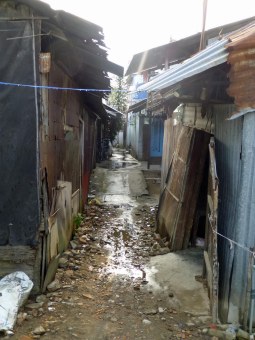Urban flooding issues and flood tolerance in Vietnam
By Tom Donahue
It’s not every day that your city streets turn into a canal system that makes you set aside the motorbike and take out the canoe. Bordering the Tropic of Cancer in the north and the equator in the south, Vietnam gets between 60 and 100 inches of precipitation each year.  Combined with the two delta river systems that drain the Himalayan mountains and direct precipitation, Vietnam’s natural environment is adapted for the most dramatic influx of water than anywhere else on Earth. Paired with clay soil and dense vegetation, the system can tolerate variable weather, but anthropogenic perturbations have lessened the system’s resiliency.
Combined with the two delta river systems that drain the Himalayan mountains and direct precipitation, Vietnam’s natural environment is adapted for the most dramatic influx of water than anywhere else on Earth. Paired with clay soil and dense vegetation, the system can tolerate variable weather, but anthropogenic perturbations have lessened the system’s resiliency.
 The urban environment in Vietnam, as it is built today, has blanketed the soil and removed the vegetation. Impermeable infrastructure like asphalt roads and concrete buildings have replaced much of the permeable environment leaving green spaces and drainage systems to absorb or funnel the storm water underground or to the ocean. Even the rural areas we have visited are increasingly removing native vegetation and paving over the landscape. Impermeable surfaces in Vietnam are putting public health, the environment, and the economy at risk by increasing polluted water, land use changes, and costs from flood damages, respectively.
The urban environment in Vietnam, as it is built today, has blanketed the soil and removed the vegetation. Impermeable infrastructure like asphalt roads and concrete buildings have replaced much of the permeable environment leaving green spaces and drainage systems to absorb or funnel the storm water underground or to the ocean. Even the rural areas we have visited are increasingly removing native vegetation and paving over the landscape. Impermeable surfaces in Vietnam are putting public health, the environment, and the economy at risk by increasing polluted water, land use changes, and costs from flood damages, respectively.
The streets are littered with packaging and food scraps from daily activities; and oils from places like motorbike shops are washed into the streets nightly. Vietnam has yet to have a Lady Bird Johnson of their own to campaign against street littering or proper disposal of toxic chemicals.  Industrial waste is less regulated, which contributes to unsafe levels of chemical discharge and emissions whose impacts are felt locally.
Industrial waste is less regulated, which contributes to unsafe levels of chemical discharge and emissions whose impacts are felt locally.
When the rains come, the drainage systems reach capacity quickly when the rivers overflow. Locals say the street trash clogs storm drains frequently, which increases the amount of water on the streets and prolongs inundation.  Most Vietnamese do not own cars; they own motorbike, bicycles, or walk, so many people are exposed to a mixture of storm water and pollutants that may cause skin allergies. Climate change will increase the severity of rain events that exacerbates rapid flooding and prolonged inundation.
Most Vietnamese do not own cars; they own motorbike, bicycles, or walk, so many people are exposed to a mixture of storm water and pollutants that may cause skin allergies. Climate change will increase the severity of rain events that exacerbates rapid flooding and prolonged inundation.
Impermeable surfaces rely on drainage systems to remove flood water from those surfaces, but an inefficient system increases the time water lays stagnant. Most streets and sidewalks in Vietnam are not ADA certified (fit for wheelchairs) meaning potholes, large cracks, and divots sprinkle the streets. Depressions in the streets that fill with stagnant water are suitable environments for mosquitos to reproduce, and may lead to an increase of dengue fever. Leaving Ho Chi Minh City in the bus, urban sprawl was apparent seeing large bridges, roads, and buildings under construction continuous for an hour from the city center. As deforestation and impermeable surfaces increase, the surrounding environment is losing its capability to effectively manage flooding favoring some wildlife over others.
New Year’s Eve was a direct look at Vietnams traffic potential; there was bumper to bumper motorbike traffic for seven hours with dry streets. The streets have potential to hold a foot or two of water during the rainy season, which slows traffic considerable. Having only seen pictures and water stains on the sides of buildings, one can only imagine how difficult it would be finding traction. Sitting lower than the average car, motorbike exhaust pipes make the motorbike susceptible to suffocation and engine failure. With dozens of immobile motorbikes, it makes transportation extremely burdensome. The economy suffers a great deal from restricted activities during the floods and the cost of reconstruction when the water subsides.
 Vietnam cannot stop the flooding; it is engrained into the culture and the landscapes. However, increasing permeable surface area with different paving techniques or increasing green space will prevent disease, replenish groundwater, and reduce inundation and costly centralized storm water system upgrades.
Vietnam cannot stop the flooding; it is engrained into the culture and the landscapes. However, increasing permeable surface area with different paving techniques or increasing green space will prevent disease, replenish groundwater, and reduce inundation and costly centralized storm water system upgrades.

Leave a comment